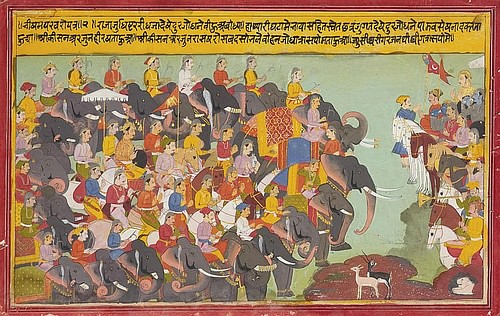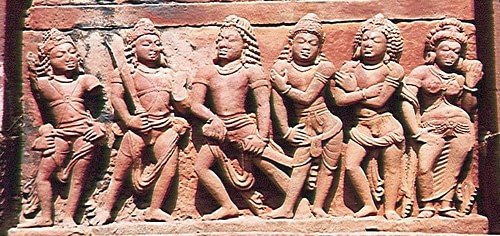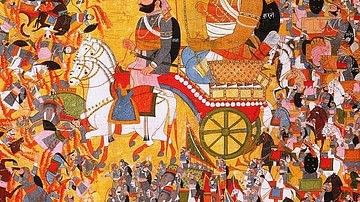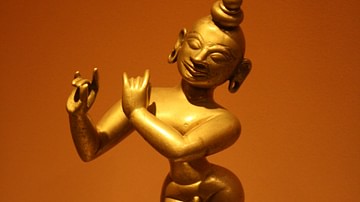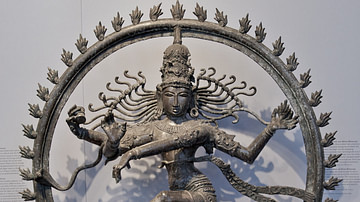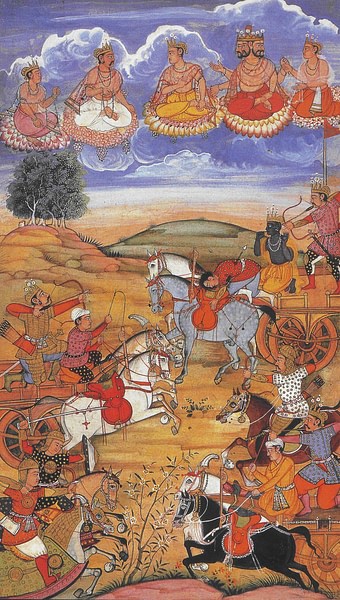
The Bhagavad Gita (“Song of God” or “Song of the Lord”) is among the most important religious texts of Hinduism and easily the best known. It has been quoted by writers, poets, scientists, theologians, and philosophers – among others – for centuries and is often the introductory text to Hinduism for a Western audience.
It is commonly referred to as the Gita and was originally part of the great Indian epic Mahabharata. Its date of composition, therefore, is closely associated with that of the epic – c. 5th-3rd century BCE – but not all scholars agree that the work was originally included in the Mahabharata text and so date it later to c. 2nd century BCE.
The Gita is a dialogue between the warrior-prince Arjuna and the god Krishna who is serving as his charioteer at the Battle of Kurukshetra fought between Arjuna's family and allies (the Pandavas) and those of the prince Duryodhana and his family (the Kauravas) and their allies. This dialogue is recited by the Kauravan counselor Sanjaya to his blind king Dhritarashtra (both far from the battleground) as Krishna has given Sanjaya mystical sight so he will be able to see and report the battle to the king.
The Kauravas and Pandavas are related and there are mutual friends and family members fighting on both sides for supremacy of rule. Accordingly, when Arjuna sees all his former friends and comrades on the opposing side, he loses heart and refuses to take part in a battle which will result in their deaths as well as many others. The rest of the text is the dialogue between the prince and the god on what constitutes right action, proper understanding and, ultimately, the meaning of life and nature of the Divine.
The Gita combines the concepts expressed in the central texts of Hinduism – the Vedas and Upanishads – which are here synthesized into a single, coherent vision of belief in one God and the underlying unity of all existence. The text instructs on how one must elevate the mind and soul to look beyond appearances – which fool one into believing in duality and multiplicity – and recognize these are illusions; all humans and aspects of existence are a unified extension of the Divine which one will recognize once the trappings of illusion have been discarded.
The Gita inspired the Bhakti (“devotion”) Movement which then influenced the development of Buddhism, Jainism, and Sikhism. Krishna explains the path of selfless devotion as one of the paths toward self-actualization, recognition of the truth of existence, and liberation from the cycle of rebirth and death; the other two being jnana (“knowledge”) and karma (“action”). The Hare Krishna Movement of the present day is an expression of Bhakti, and the Gita remains their principal text.
Vedas, Upanishads, & the Three Gunas
Hinduism is known to adherents as Sanatan Dharma (“Eternal Order” or “Eternal Path”) and is informed at its fundamental level by the texts known as the Vedas which also include subtexts known as the Upanishads. The word Veda means “knowledge”, and Upanishad is interpreted to mean to “sit down closely” as though drawing near for instruction from a master. The Vedas convey the essential knowledge of the universe; the Upanishads instruct one on how to use that knowledge.
The vision of the Vedas and Upanishads, in its simplest and most concise form, is that there is a single entity – Brahman – who is the creator of existence and existence itself. Human beings carry a spark of this great Divinity within themselves known as the Atman. The purpose of life is to reach the self-actualization of the Atman which will then bring one into union with Brahman in life after one experiences physical death. One achieves this self-actualization through the performance of one's dharma (duty) in accordance with one's karma (right action) to eventually attain moksha (liberation) and the recognition of Final Truth. If one does not attain self-actualization in a given lifetime, one is reincarnated and must try again.
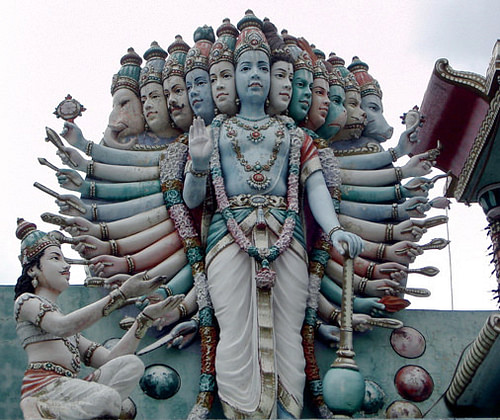
- Sattva – wisdom, goodness, enlightenment
- Rajas – passion, activity, aggression
- Tamas – darkness, confusion, helplessness
The gunas are not a hierarchy one needs to work through from bottom to top but all three exist, to greater or lesser degrees, in every individual. The confusion of Tamas can be caused by the passion of Rajas and the urge toward goodness or wisdom of Sattva. The gunas help to enslave the mind by interpreting the world one sees as the truth – as the way life and the universe truly are – and so trap one in the cycle of rebirth and death (samsara), keeping one from self-actualization by diverting attention from the truth of reality to what one has been taught to accept as reality.
The best illustration of this is the interpretation of death as a tragic loss both for the deceased and for the survivors. One's natural response to death is sorrow and anger at the loss or, for those experiencing the decline in health of a terminal disease, fear of the unknown and rage at being forced to leave all one knows behind. The sages of the Upanishads and the figure of Krishna in the Gita would say these responses are simply the gunas at work. One is conditioned to respond emotionally to loss but, depending on which of the three gunas is most dominant in an individual, one will express that emotion in different ways. The soul possessing more of Sattva will be inclined to be philosophical and optimistic; of Rajas, angry and aggressive; of Tamas, inconsolable and despairing.
None of these responses, Krishna would say, are appropriate because the person who has died has not ceased to exist and one commits a serious spiritual error in responding as though they have. Even the response of Sattva is not wholly appropriate because it supposes an end to life, a discontinuity, when there is none. The soul is immortal, existed before birth, and exists after death. This understanding is emphasized in the Upanishads and illustrated dramatically throughout the Gita which stresses the importance of moving beyond what seems to be true toward actual Truth.
Mahabharata & Gita Summary
As noted, the action of the Gita is set in the great Indian epic Mahabharata which focuses on the interrelated families of the Pandavas and Kauravas and their struggle for control of the land of Bharat (India). The work is traditionally attributed to the sage Vyasa (as is the Gita by some, said to have been dictated by Vyasa to the elephant-headed god Ganesha) and illustrates spiritual truths through its epic tale.
The Vedas (and, to some schools of thought, the Upanishads) are considered shruti (“what is heard”) by Hindus in that the works are considered eternal knowledge communicated by the Divine and heard by sages who then preserved them. The Mahabharata, the Gita, and the other great epic, the Ramayana, are considered smritis (“what is remembered”) as they are regarded as works written by human beings drawing on past history, lore, and tradition. It should be noted that, in some Hindu sects (such as the Hare Krishna movement), the Gita is understood as shruti on par with the Vedas, but this claim is not commonly accepted.
The Mahabharata begins with the story of the king Shantanu of the Kuru clan who sets in motion a series of events whereby his second wife, Satyavati, comes to control the kingdom along with their son Devavrat (also known as Bheeshm). Bheeshm captures three princesses from another kingdom as wives for his half-brother Vichitravirya, who was to be crowned king. One of these was released and the other two married Vichitravirya who then died without producing an heir. The two princesses were then married to Satyavati's son from her first marriage, the sage Vyasa, in order to preserve the Kuru line. One of the princesses gave birth to Dhritarashtra (who was born blind) and the other to Pandu. Vyasa then had a third son with a maid of the ladies who was called Vidur. All three boys showed exceptional skills in different areas of government.
In time, Dhritarashtra was married to the princess Gandhari and Pandu to another named Kunti. The two princes and Vidur consolidated the rule of the kingdom and, when they came of age, Pandu became king even though Dhritarashtra was older because a blind man could not legally rule. Pandu reigned well and, when all seemed in order, Pandu requested leave and went off to live in the woods with Kunti and his lesser wife Madri. Years later, Kunti returned with her five sons who had been born in the wilderness – Yudhishthira, Bhima, Arjuna, and the twins Nakula and Sahadeva – along with the corpses of Pandu and Madri whose deaths have brought the family back to the kingdom. These sons (known as the Pandavas) are attributed to Pandu as father but, actually, each was conceived by the union of Kunti and Madri with different gods.
While Pandu and his wives were gone, Dhritarashtra and Gandhari had produced 100 children, the oldest of whom was Duryodhana, known as the Kauravas. Rivalry between Duryodhana's side of the family and the five sons of Kunti informs the rest of the story which finally results in the armies of the two branches of the family facing each other at the Battle of Kurukshetra.
This is where the action of the Gita takes place, just before the battle is about to begin. Krishna, in his present incarnation, is related to both sides and declares he will fight for neither but assist both. He serves as Arjuna's charioteer and, as both armies move into position for battle, Arjuna asks Krishna to drive him to the center of the field so he can look upon all of those who are so eager for war. When Krishna obliges, Arjuna sees his friends, relatives, old teachers, counselors, all of the people who played a part in his life and made him who he is. He tells Krishna that he cannot be a part of any action that will result in so much death and misery. He throws down his great bow and declares he will not fight.
Prior to the battle, Krishna endowed the counselor Sanjaya with a kind of second sight so that, even miles away, he could see everything taking place on the battlefield and report it precisely to Dhritarashtra. The Gita begins with Dhritarashtra asking Sanjaya what is happening at Kurukshetra; Sanjaya then narrates Arjuna's despair, Krishna's response, and the whole of their dialogue which finally culminates in Arjuna's understanding of the nature of existence, his place in the cosmic order, and why he has to take part in the coming battle.
The Mahabharata then continues as Arjuna picks up his bow to fight. The Pandavas win but at the cost of almost their entire army. Duryodhana and the Kauravas are all killed. Yudhishthira and his brothers then rule the land for 36 years before abdicating in order to pursue peace in their final days in the Himalayas where they die and are brought to paradise.
Right Action & Wrong Action
The action of the Gita, Arjuna's despair, and final realization of Truth touches on many different aspects of Hindu belief but central is the concept of dharma and an ordered universe where each person has a responsibility to do what they have been placed on earth to do and which no one else can accomplish. Krishna impresses on Arjuna how he is a warrior, and it is a warrior's duty to take up arms and engage in battle, but this argument fails to convince Arjuna because all he sees are his friends and relatives who will soon be killed.
Krishna then has to go beyond the conventional argument of dharma to explain its underlying form, importance, and how one is only distracted from it by the gunas which contribute to false understanding and the acceptance of illusion. In one of the most famous passages of the Gita, Krishna tells Arjuna:
Whether the slayer thinks he slays
Or the slain thinks he is slain,
Both are wrong.
There is neither slayer nor slain. (II.19)
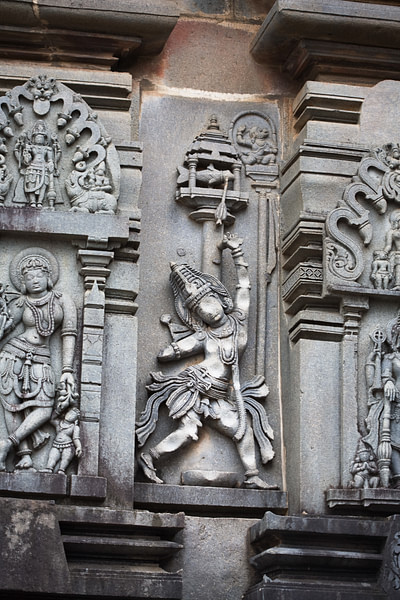
The soul is immortal, Krishna is saying, and so death is only an illusion. Death is discarding a body that no longer functions but it has nothing to do with the Higher Self of an individual, the Atman, which is immortal and, once it has shed the body, will return to its eternal home through union with Brahman. One must break free of illusion to recognize the truth that all things observable and unobservable are actually Brahman – all of the people in the armies facing each other on the battlefield are Brahman – all of the people of the country – everyone, everywhere – is Brahman. One is free to pursue right action in life once one understands the essential unity of all things:
When the bonds are broken
[the believer's] illumined heart
Beats in Brahman:
His every action
Is worship of Brahman:
Can such acts bring evil?
Brahman is the ritual,
Brahman is the offering,
Brahman is he who offers
To the fire that is Brahman.
If a man sees Brahman
In every action,
He will find Brahman. (IV.2)
This recognition encourages detachment from the seeming consequences of one's actions. One must realize, Krishna is saying, that engaging or refusing to engage in a certain course because one is focused on the probable outcome is to be blinded by illusion which will cause one to fail in performing their essential duty in life. One must detach one's self from the consequences of one's action and focus on what must be done, no matter how seemingly painful, in order to play the part one has been given in the Eternal Order of the universe.
In Arjuna's case, refusing to fight is refusing to do his dharma which means not only evading his responsibilities but denying the truth of the nature of existence. The battle must be fought because all the overtures and attempts to resolve the conflict peacefully have failed. Those involved have all made choices which have brought them to Kurukshetra and battle; there is no way, at this point, that Arjuna can do anything other than fight, even if he does not wish to. Once Arjuna realizes this, he is at peace with what he must do, and the battle commences.
This dramatic situation, of course, applies to anyone in the same situation facing some difficulty they would prefer to avoid. An audience is comforted by the Gita in that if Arjuna could recognize his dharma and kill his friends, relatives, and former teachers, then whatever one may be facing in one's own life should be much easier to bear.
Conclusion
There are many other aspects to the Gita than just the importance of dharma. Krishna's speeches throughout 18 chapters illustrate the nature of the Divine, Divine Love, how an individual should respond, and how the universe is ordered. At one point, Krishna – who is an avatar of the god Vishnu - reveals himself as Brahman itself thereby showing how all the many gods of Hinduism are also Brahman in varied forms. Krishna also discusses the so-called Caste System (the varnas) which allows each individual to perform his dharma without distraction. The four varnas are:
- Brahmana varna – highest caste, teachers, priests, intellectuals
- Kshatriya varna – warriors, police, protectors, guardians
- Vaishya varna – merchants, farmers, bankers, clerks
- Shudra varna – lowest caste, servants, laborers, unskilled workers
Below the Shudras are the untouchables known as the Dalits, those who exist outside of the caste system.
In the Gita, the varnas are explained as open to anyone. Anyone whose dharma it is to be a teacher should be a teacher, no matter what social class they are born into. This vision was transformed into a legalistic system by the Laws of Manu (the Manusmriti) written in the 2nd century BCE - 3rd century CE, under which one's caste determined one's occupation and social parameters, but this was not the original vision of the Gita.
The emphasis of the Gita on devotion, knowledge, and right action in understanding and drawing near to God would seem to preclude a legal caste system which confines one to the social class of his or her birth. The Laws of Manu, however, sidestep this criticism by claiming that the caste system is divinely ordained and part of Universal Order. One has been born to a certain caste because of the karma of a past life which must be dealt with in this life because it was neglected before.
As noted, the Gita would inspire the religious movements which would come to be known as Buddhism, Jainism, and Sikhism, all of which – to greater or lesser degrees – emphasize the importance of devotion to a personal God, Higher Power, or Greater Good as central to their vision. The Gita has since inspired many others besides the famous Hare Krishna movement of the present day through the compassion of its message of Universal Love, emphasis on personal responsibility to one's self and others, and the underlying unity of all living things.
The differences people note in each other – as well as the seeming tragedy of loss and death - are recognized as illusions, the Gita says, once one has moved past the acceptance of appearance to an apprehension of reality-as-it-is. In the end, all are a part of the essence of the Universe and can only begin to work toward this realization by first recognizing it as the truth. Among Hindu texts, the Gita is the fullest expression of this concept of the means toward self-actualization and liberation which free the soul from the illusions which cause suffering and reward one with peace in this life and union with God after death.
